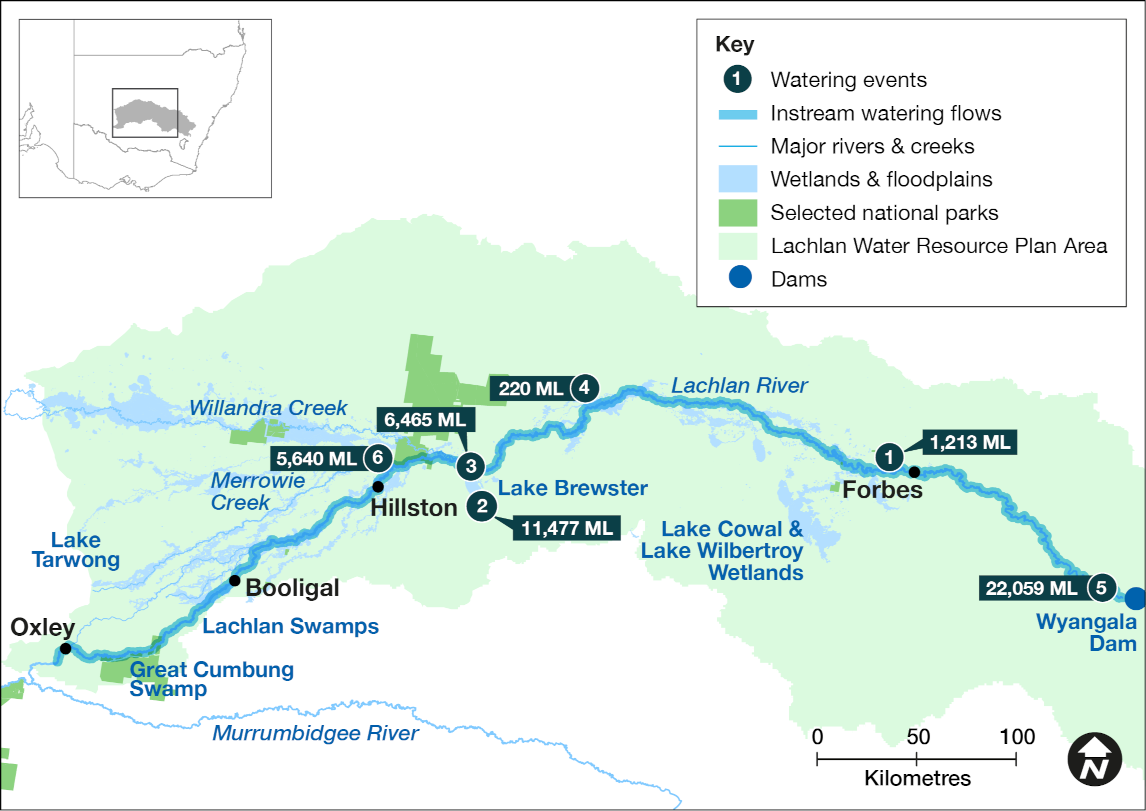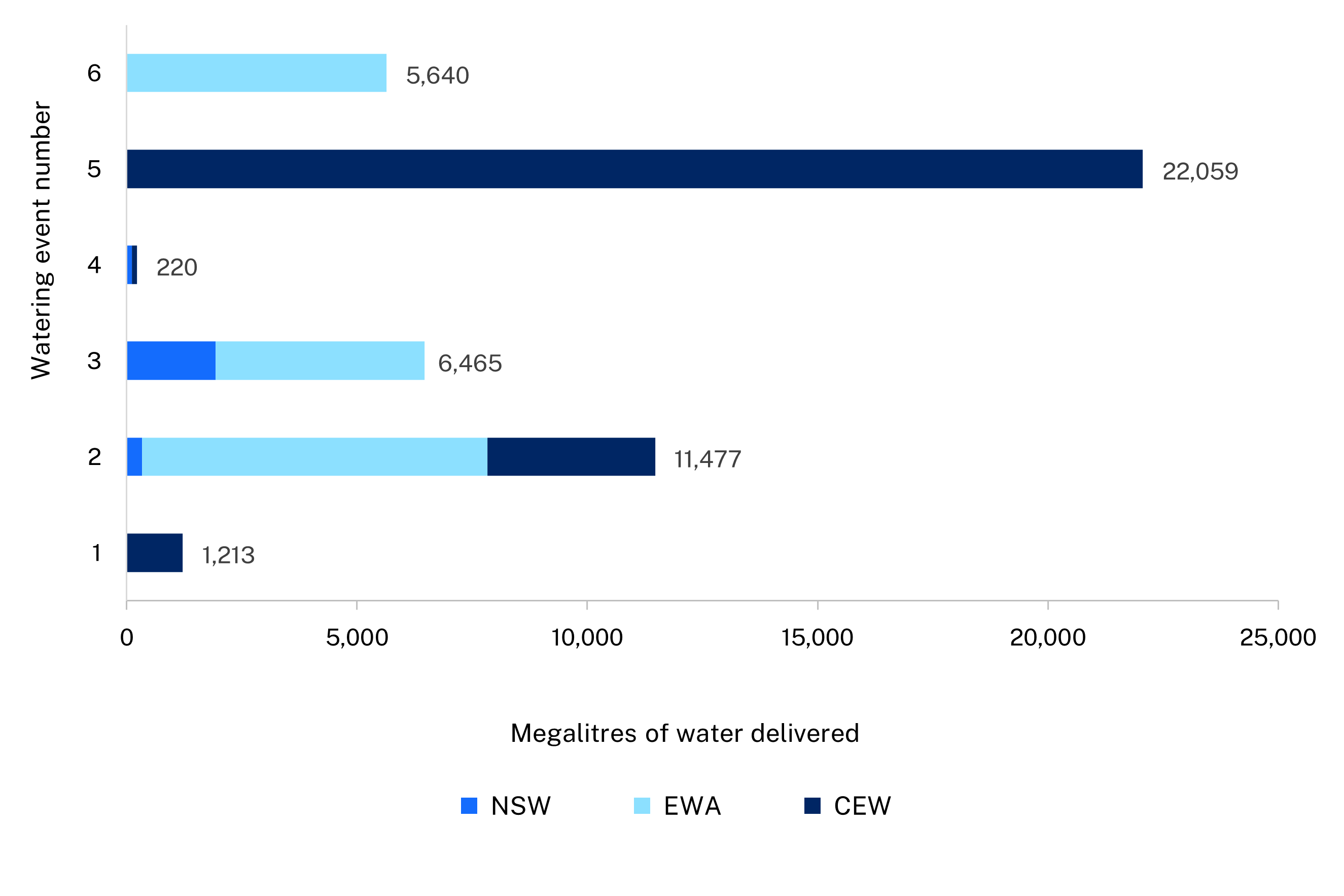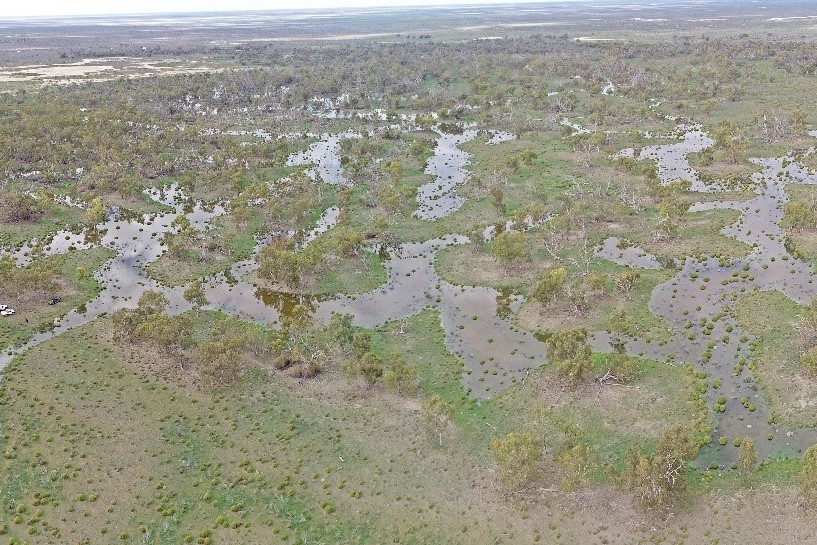Environmental flows provided for successful Australian pelican breeding, recovery from blue-green algal blooms, and lateral connectivity to support cultural and ecological values in 2023–24.
Key outcomes
Under very wet conditions, environmental water managers worked with partner agencies and stakeholders to coordinate the delivery of water for the environment to:
- support the largest Australian pelican event in the Murray–Darling Basin, with almost 23,000 nests to completion at Lake Brewster for the third consecutive season
- combine with the Lachlan Water Quality Allowance to respond to an acute blue-green algal bloom below Lake Brewster in the lower Lachlan to support native fish and other aquatic biota
- provide an autumn fresh below Wyangala Dam to restore longitudinal connectivity, support common reed beds, Australasian bitterns and southern bell frogs, as well as maintain improved water quality to benefit native fauna in the Great Cumbung Swamp
- enhance the recovery of lignum shrublands and fringing aquatic vegetation of Merrowie Creek and fill Lake Tarwong in anticipation of spring waterbird requirements
- support the priorities of Box Creek for Aboriginal peoples.

Map of the Lachlan catchment showing locations of water for the environment deliveries made in the 2023-24 water year with corresponding volumes.
Catchment conditions
Climatic conditions in the Lachlan catchment swung from a moderate to wet winter to a dry El Niño summer before finishing the year on La Niña watch.
Partnering with Aboriginal peoples
Water for Country is environmental water use planned by the Department of Climate Change, Energy, the Environment and Water and Aboriginal people to achieve shared benefits for the environment and cultural places, values and/or interests.
The Lachlan Environmental Water Advisory Group visited Box Creek with Mutthi Mutthi elders in March 2024. Mutthi Mutthi had partnered with landholders in a submission requesting the cultural values and connection to Box Creek be recognised in watering plans. Shortly after in May 2024, an environmental watering action targeting Merrowie–Lake Tarwong–Box Creek was in progress.
The Greater Cumbung Region Water Management Plan and Working Together Plan was finalised, and a program of On Country activities co-designed with Aboriginal community representatives is under way.
Environmental water managers worked with the Wiradjuri Condobolin Centre to identify barriers and constraints for the Murie Creek and provide opportunities to learn about fish monitoring.
Watering aims
Under predicted moderate to wet weather and water availability, the Lachlan Environmental Water Advisory Group developed its Annual environmental water priorities in the Lachlan catchment 2023–24.
Aims for the use of water for the environment were to:
- extend inundation of river red gum, black box and lignum floodplain wetlands in the lower Lachlan distributary creeks (Willandra, Merrowie and Merrimajeel)
- provide high-quality habitat for waterbird breeding, foraging and dispersal
- support waterbird breeding events at multiple rookery sites as they occur
- extend longitudinal and lateral connectivity from translucent or tributary flows in the Lachlan swamps and Great Cumbung region
- promote seed setting and establish aquatic plants in the Lake Brewster inflow wetland.
Under wet conditions, environmental water managers achieved all aims except to establish aquatic plants in the Lake Brewster inflow wetland because water levels remained too high. Working with natural cues and flows, key floodplain and wetland connections were enhanced, providing opportunities for plants and animals to breed, move and thrive. Water quality issues were largely addressed with the Lachlan Water Quality Allowance in concert with key interventions of environmental water.
Water delivery
This table and chart provide a summary of 47,074 megalitres of water for the environment delivered in the Lachlan catchment during the 2023–24 water year, in addition to the full 20,000 megalitres of the Lachlan Water Quality Allowance. The catchment experienced an El Niño summer and above median autumn–winter rainfall ending in a La Niña watch.
Figures were accurate at the date of publishing, but maybe adjusted. Watering event numbers in the table and chart relate to location numbers marked on the map.

Water delivery to the Lachlan catchment in the 2023-24 water year.
Notes: CEW = Commonwealth licensed environmental water; EWA = environmental water allowance accrued under the water sharing plan; NSW = NSW licensed environmental water.
| Water event number | Event name | Outcomes | Start date | Finish date |
|---|---|---|---|---|
| 1 | Murray cod nesting flow | Native fish | 26 September 2023 | 2 October 2023 |
| 2 | Lake Brewster pelicans | Waterbirds | 28 September 2023 | 25 May 2024 |
| 3 | Summer refuge flows | Native fish | 11 February 2024 | 11 March 2024 |
| 4 | Booberoi | Connectivity, native fish, waterbirds | 20 February 2024 | 27 February 2024 |
| 5 | Lachlan River autumn fresh | Native fish | 12 March 2024 | 26 March 2024 |
| 6 | Merrowie-Box Creek | Native vegetation | 10 April 2024 | 13 June 2024 |
Outcomes
In 2023–24, NSW environmental water managers worked with the Commonwealth Environmental Water Holder, stakeholders and the community to deliver 6 watering actions across the catchment. This included:
- taking unprecedented action to not deliver water from Lake Brewster storage for 3 months, removing the risk of rapidly draining the wetland and mass abandonment of Australian pelican chicks/fledging young. This successfully resulted in almost 23,000 nests being built, which was the largest breeding event in the Murray Darling–Basin that season.
- supporting Murray cod nesting in the upper and mid-Lachlan River, and protecting a natural fresh through Booberoi Creek
- responding immediately to an acute blue-green algal bloom in the Lachlan River near Hillston, with high flushing dilution flows, followed by the use of the Lachlan Water Quality Allowance. The Lachlan Environmental Water Allowance continued to maintain the improvements in water quality for several weeks, including increased dissolved oxygen and lower algal biovolumes. This helped aquatic biota recover from a period of stress during the peak of summer heat waves along the entire lower Lachlan River
- delivering a system-scale Lachlan River autumn fresh from Wyangala Dam to increase flowing habitat along the length of the river, including into the mid-Lachlan anabranch and Booberoi system
- improving floodplain plant resilience in the Great Cumbung Swamp and maintaining habitat for native birds and frogs leading into their breeding season
- consolidating outcomes and ecological objectives achieved by earlier use of the Lachlan Water Quality Allowance and Lachlan Environmental Water Allowance
- providing vital follow-up watering to the nationally significant Merrowie Creek and Box Creek floodplain system, including filling Lake Tarwong.
Case study: Reviving Merrowie–Box Creek
Over 390 km of Merrowie Creek floodplain and wetlands were watered from 10 April to 13 June 2024 using 5,640 megalitres of environmental water. This event was an unparalleled success because water was delivered in half the time and at one third of the volume of previous watering actions with the same intent.
The successful and efficient delivery of water was partly due to NSW and Commonwealth environmental water managers, WaterNSW, Merrowie and Box creek landholders, and the Merrowie Creek Trust District collaborating to deliver environmental water in a different way. For the first time, stock and domestic replenishment and environmental water was delivered together. In addition, water delivery started in early April whereas in previous years deliveries began in May and continued into July.
Merrowie Creek was essentially dry at the start of the watering action, but the early start meant delivery coincided with one of the ‘best autumn rainfall breaks’ in decades. The contribution of local rainfall and sub-soil moisture is important.
The initial target of the watering action was Lake Tarwong located at the end of the 390-km long Merrowie Creek, which branches off the Lachlan River near Hillston. Lake Tarwong is a river red gum–lignum wetland in the middle of a semi-arid floodplain. Supporting waterbird breeding and foraging habitats was another goal of the watering action.
Historically, Lake Tarwong and the entire floodplain upstream had healthy, robust areas of lignum. Increasing the extent and condition of lignum shrublands over the floodplain is one of the objectives in the Lachlan catchment’s long-term water plan.
Lake Tarwong itself was once a thriving breeding site for waterbirds, such as straw-necked and glossy ibis that nest together in large groups. The first historical video footage of freckled duck nesting was taken at Lake Tarwong, and southern bell frogs were also common inhabitants.
Lake Tarwong is part of the nationally significant Merrowie Creek wetland system – Cuba Dam to Chillichil Swamp and Box Creek. Given the location of this wetland system at the end of a long distributary, ephemeral creek, the system receives less regular inundation under regulated river conditions. It was also heavily impacted by the Millennium Drought.
The floodplain vegetation is still in the early stages of recovery, despite the previous 2 years of inundation. This follow-up environmental flow will consolidate the incredible transformation of the lower Merrowie Creek floodplain.
Before environmental water was delivered in 2020, parts of the landscape were dominated by terrestrial plants. There was no cumbungi, reeds, or rushes. Four years later the landscape has been transformed. Lignum trees and shrubs that were merely woody stumps in early 2020 are now bushy and full of new growth, and provide important habitat for a range of native animals including endangered southern bell frogs and bustards.
Box Creek, below Lake Tarwong, has significant environmental and cultural meaning for the Mutthi Mutthi people. Having exceeded the initial goal of filling Lake Tarwong, environmental flows continued towards Chillichil Swamp, over 80 km further downstream. Although environmental flows did not reach and fill Chillichil Swamp, the substantial watering of the upstream floodplain means the translucent and unregulated flows following behind have a greater chance of achieving that goal.

The lower Merrowie Creek floodplain in the Lachlan catchment.